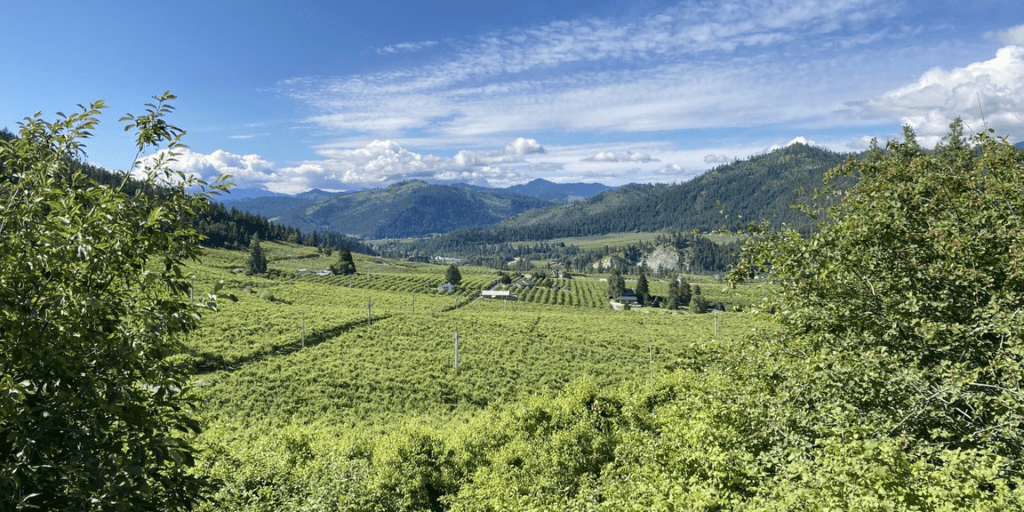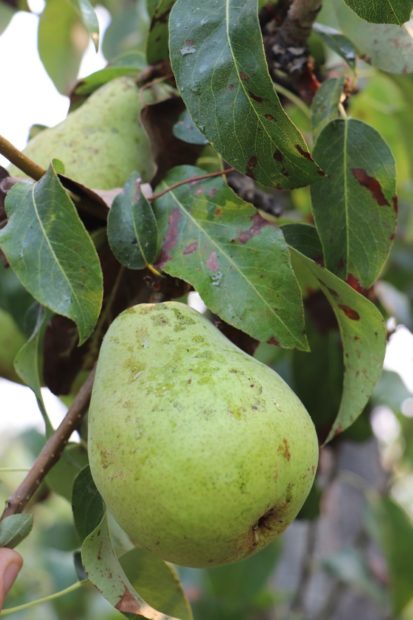We have much more to do and your continued support is needed now more than ever.
Lessons from a Leaf: The Wild World of Orchard Insects

It’s harvest time in central Washington. Daybreak in the pear orchards of the Wenatchee Valley is accompanied by the sound of ladders clanking, tractors roaring to life, and pickers singing along to radios belting out tunes. The sounds are deeply familiar—I grew up in a family orchard a few miles from here and after a childhood of playing and working among pear trees, this summer I had the opportunity to research them. As I make my way through a Bartlett and d’Anjou orchard, I observe two deer scatter from the human activity. Armed with a pair of pruners and a roll of Saran wrap, I’m on a hunt for less noticeable wildlife: the insects that call these pear trees home.
When we think about Northwest wildlife, we usually think of salmon, wolverines, bears, beavers, and bald eagles. Smaller, with alien features and a distinct lack of cuddliness, insects are often overlooked. However, they are everywhere and are a crucial part of nearly every ecosystem. Orchards are no exception: put a pear leaf under a microscope in July and you’ll find an abundance of minuscule life.
When we consider the role of insects in agriculture, we tend to focus on two categories: the pests and the pollinators. But for those who are unacquainted with the insect wildlife in our orchards, there is an important third category. Ladies and gentlemen, I give you (drumroll please) … the natural enemies!
Natural enemies are insects that are predators of orchard pests—such as the widespread and destructive pear psylla. Pear psylla are small cicada-like bugs that secrete honeydew which damages fruit and makes harvest conditions extremely sticky and miserable for farmworkers; in large numbers, psylla can also defoliate and kill fruit trees. Psylla are especially problematic because they develop resistance to insecticides rapidly, making spray treatment programs less and less effective over time. But they are no match for the ladybug or lacewing you see daily in your garden!
Psylla, spider mites, codling moths, and other orchard pests are, well, pesky and raise some interesting questions. How can we manage orchard pests in a way that is both environmentally friendly and economically sound? More importantly: Is it possible to recruit the natural enemies to help combat these pests?
I’ve been working on the ground to find out. For four months this summer I’ve distributed sticky card traps, wedged cardboard “earwig hotels” between branches, compiled pheromone lures, collected leaf samples, constructed sprinkler systems to “wash” trees of honeydew, and identified thousands of insects in the field and lab. I got to know psylla and their natural enemies on a first-name basis with the goal to provide orchardists pest-management alternatives that don’t negatively impact other orchard wildlife. Using “softer” and more selective spray programs that allow natural enemies to survive means that we may gain a number of new insect allies.
The Enemy of My Enemy
Natural enemies come in many shapes and sizes. Spider mite destroyers are tiny black lady beetles that (as advertised) destroy spider mite populations. Trechnites wasps lay eggs inside a psylla nymph so when their young hatch they devour the nymph from the inside out, forming an empty psylla “mummy.” A single lime green Campylomma bug can eat hundreds of psylla eggs in a life cycle! The more widely known species such as earwigs, lacewing, ladybugs, and scores of different spiders are also part of the battalion of natural enemies.
Natural enemies are our allies because orchards and surrounding areas are brimming with all kinds of wildlife. Hummingbirds zip through trees, osprey circle the river, and turkey vultures soar above the train tracks. Quail, grouse, and wild turkeys parade with their chicks and red-winged blackbirds trill from swampy areas. Coyotes pad through the brush, cougars and cubs are seen romping in the cherries and a bobcat recently patrolled the irrigation canal near my house. As farmers, we have a responsibility to preserve the health of this diverse ecosystem as well as put food on the table.
We tend to think of commercial agriculture as clean, sterile, and controlled, with an instinct to keep wildlife (including insects) out of the orchard. However, by looking at pest management through an ecological lens, we can lessen our impact on a complex and vibrant ecosystem and maintain the balance of wildlife populations, pests and natural enemies included.
It’s some food for thought you might consider when you bite into a crispy pear this fall!
























